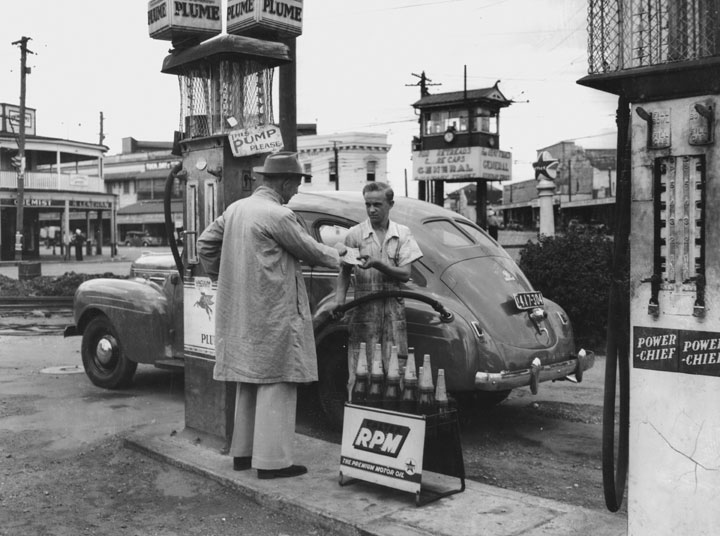Description
This black-and-white photograph was taken in 1949 at a time when wartime petrol rationing was still in force. It shows petrol bowsers on the dirt apron of a garage at the Fiveways in Woolloongabba, Brisbane. A customer in hat and coat pays with what are probably petrol ration coupons. The mechanic, dressed in grubby overalls, is pumping petrol from a Plume bowser topped by a glass fuel reservoir into what appears to be a late 1930s Ford Sloper Coupe automobile. A tram signal box and commercial buildings can be seen in the background.
Educational value
- In November 1949, petrol rationing was a significant issue in the forthcoming federal election campaign. After the Second World War had ended there was an expectation that times would become easier and rationing would finish. The Labor government abandoned it in June 1949, but then resumed it in November following hoarding and disruption of industries. This led to its defeat in the December election. Prime minister Menzies ended rationing in 1950.
- Petrol rationing was introduced in 1940 as Australia, which produced no oil of its own and had inadequate storage facilities, had only three months’ supply at the start of the War and depended on the procurement of stocks from overseas and their safe arrival. Rationing was introduced to ensure fair access by everyone to scarce goods. Ration books containing coupons were distributed and in the case of petrol entitled the owner to a monthly ration.
- The garage’s mechanic is serving the petrol, in the days before self-serve, as the primary role of garages in those days was the repair of automobiles. Skill was needed to pump the Plume (eventually to become Mobil) petrol from an underground tank. First the volume was measured out by using the lever of a graduated scale on the bowser’s front. The fuel was then hand pumped to the glass reservoir on the top and then released into the car’s filler pipe.
- The signalman’s box in the background, from which the signalman controlled the trams at this complicated intersection, was an important component in Brisbane’s tram system. To ensure safety at intersections where several tramlines met, the signalman in his cabin high above the roadway set the points and red and green signals to control tram movements through the intersection. The tram network in Brisbane was closed down in 1969 and replaced by buses.
- To avoid the problems of petrol rationing that the man in the photograph experienced, other drivers resorted to various means to continue to travel during the Second World War and for a time after. Some people installed gas producers on the backs of their vehicles in which a fuel made of wood ash was used. Others used power kerosene, motor spirit or turpentine and some a horse and cart. Others just put their cars up on blocks for the duration of petrol rationing.
- The vehicle in the photograph is probably a 1930s Ford Sloper Coupe model made only in Australia. The Slopers were made by General Motors with similar models being Chevrolet, Buick and Oldsmobile. The War had halted much automobile production but in 1948 Australia’s first successful mass-produced unique vehicle, the Holden, was launched by prime minister Chifley with demand outstripping supply and potential customers waiting until 1949 and beyond.
